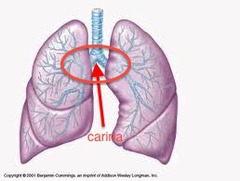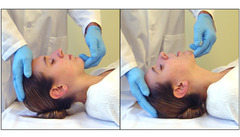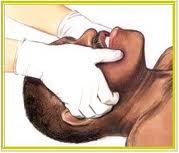EMT-B Airway Management, Ventilation, and Oxygen Therapy – Flashcards
Unlock all answers in this set
Unlock answersquestion
Adam's apple
answer
see thyroid cartilage
question
agonal respiration
answer
gasping type respirations that have no pattern and occur very infrequently; a sign of impending cardiac or respiratory arrest. Also called atonal breathing.
question
alveolar ventilation
answer
the amount of inspired air that reaches the alveoli of the lungs.
question
alveoli
answer
small air sacs in the lungs that fill with air on inspirations and are the point of gas exchange with the pulmonary capillaries
question
automatic transport ventilator (ATV)
answer
a positive pressure ventilation device that delivers ventilations automatically
question
bag-valve-mask devise (BVM)
answer
a positive pressure ventilation device that consist of a bag with non-rebreather valve and a mask. The bag-valve device is connected to the mask or other airway. The bag is squeezed to deliver a ventilation to the patient
question
bilaterally
answer
on both sides.
question
bradypnea
answer
a breathing rate that is slower than the normal rate.
question
bronchi
answer
branches of the respiratory tract from the trachea into the lungs. Singular bronchus
question
bronchiole
answer
smaller branches of the bronchi. They continue to branch and get smaller, eventually leading into alveolar sacs.
question
carina

answer
the point at which the trachea splits into the right and left mainstreams bronchi.
question
chemoreceptors
answer
sense organs within the body, such as carotid and aortic bodies, that are sensitive to chemical changes in the blood, especially to levels of oxygen, carbon dioxide, and hydrogen, and that, in response, play a role in the regulation of respiration.
question
cricoid cartilage
answer
the most inferior portion of the larynx and only full cartilaginous bring of the upper airway. It is felt immediately below the thyroid cartilage.
question
cricoid pressure
answer
pressure applied to the cricoid cartilage to compress the esophagus. Also call the Sellick maneuver.
question
crowing
answer
a sound similar to that of a cawing crow that indicates that the muscles around the larynx are in spasm and beginning to narrow the opening into the trachea
question
cyanosis
answer
a bluish color of the skin and mucous membranes that indicates poor oxygenation of tissue.
question
dead air space
answer
inspired air that fills the respiratory tract but never reaches the alveoli of the lungs.
question
deoxygenated
answer
containing low amounts of oxygen, as with venous blood.
question
diaphragm
answer
the major muscles of respiration that separates the chest cavity from the abdominal cavity. (makes up 60% - 70% Oxygen intake)
question
epiglottis
answer
a small flap of cartilaginous tissue that acts as a valve and closes over the trachea during swallowing.
question
esophagus
answer
a tubular structure that serves as a passageway for food and liquids to enter the stomach.
question
exhalation
answer
the passive process of breathing air out of the lungs. Also called expiration.
question
expiration
answer
the passive process of breathing air our of the lungs. Also called exhalation
question
flow-restricted, oxygen-powered ventilation device (FROPVD)
answer
a device that consists of ventilation valve and trigger or button and is driven directly by oxygen. It is used to provide positive pressure ventilation.
question
French catheter
answer
see soft catheter.
question
gastric distention
answer
inflation of the stomach.
question
gurgling
answer
a gargling sound that indicates a fluid in the mouth or pharynx
question
hard catheter
answer
see rigid catheter
question
head-tilt, chin-lift maneuver

answer
a manual technique used to open the airway. The head is tilted back by one hand. The tips of the fingers of the other hand are placed under the chin and used to lift it up and forward.
question
hemoglobin
answer
a complex protein molecule found on the surface of the red blood cell that is responsible for carrying a majority oxygen in the blood.
question
high-pressure regulator
answer
a one-gauge regulator that is used to power the flow restricted, oxygen powered ventilation device. The flow rate cannot be adjusted.
question
hyperfusion
answer
the insufficient supply of oxygen and other nutrients to some the body's cells that result from inadequate circulation of blood. Also called shock.
question
hypopnea
answer
in adequate tidal volume in a breathing patient.
question
hypoxia
answer
a reduction of oxygen delivery to the tissues
question
inhalation
answer
the active process of breathing air into the lungs. Also called inspiration
question
intercostal muscles
answer
the muscles between the ribs. (make up 30% - 40% of Oxygen intake)
question
jaw-thrust maneuver

answer
a manual technique used to open the airway in the patient with a suspected spinal injury. The fingers are place at the angles of the jaw and used to life the jaw up and forward
question
laryngectomy
answer
a surgical procedure in which a patient's larynx is removed. A stoma is crates for the patient to breathe through.
question
larynx
answer
the part of the air passage that connects the pharynx with the trachea. Also, it is considered the orang of the voice since it contains the vocal cords.
question
lower airway
answer
the portion of the reparatory system that extends from the trachea to the alveoli of the lungs
question
minute volume
answer
the amount of air breathed in and out in one minute. Also called minute ventilation. Minute volume (MV) = Respiratory Rate (f) X Tidal Volume (Vt) Average: Minute volume = (12) breaths per minute x (500) ml per breath Minute volume = 6,000 ml or 6 liters
question
mucous membrane
answer
a thin layer of tissue that lines various structures within the body
question
nasal airway
answer
a nasopharyngeal airway
question
nasal cannula
answer
an oxygen delivery device that consists of two prongs that are inserted into the nose of the patient. The oxygen concentration delivered is from 22% - 44%.
question
nasopharyngeal airway (NPA)
answer
a curved, hollow rubber tube with a flange or flare at the top end and a bevel at the distal end that is inserted into the nose. It fits in the nasopharynx and extends into the pharynx providing a passage for air.
question
nasopharynx
answer
the portion of the pharynx that extends from the nostrils to the soft palate.
question
non-rebreather mask
answer
an oxygen delivery device that consists of an reservoir and one-way valve. it can deliver up to 100% oxygen to the patient
question
oral airway
answer
an oropharyngeal airway.
question
oropharyngeal airway (OPA)
answer
a semicircular hard plastic device that is inserted in to the mouth and holds the tongue away from the back of the pharynx.
question
oropharynx
answer
a portion of the pharynx that extends from the mouth to the oral cavity at the base of the tongue
question
oxygen humidifier
answer
a container that is filled with sterile water and connected to the oxygen regulator to add moisture to the dry oxygen prior to being delivered to the patient.
question
oxygenated
answer
containing high amounts of oxygen, as with arterial blood.
question
oxygenation
answer
the process by which the blood and the cells become saturated with oxygen.
question
parietal pleura
answer
the outermost pleural layer that adheres to the chest wall.
question
patent airway
answer
an airway that is open and clear of any obstructions.
question
pharynx
answer
the common passageway fro the reparatory and digestive tract; the throat.
question
pleura
answer
two layers of connective tissue that surround the lung.
question
pleural space
answer
a small space between the visceral and parietal pleura that is at negative pressure and filled with serous fluid.
question
pocket mask
answer
a plastic mask placed over the patient's nose and mouth through which ventilations can be delivered.
question
positive pressure ventilation (PPV)
answer
method of aiding patient whose breathing is inadequate by forcing air into lungs.
question
respiration
answer
the exchange of oxygen and carbon dioxide the takes place during inhalation and exhalation
question
respiratory arrest
answer
complete stoppage of breathing.
question
respiratory distress
answer
a condition in which a person is working harder than normally to breathe. Also called breathing difficulty.
question
respiratory rate
answer
the number of breaths taken in one mine. Also called frequency.
question
retractions
answer
depressions seen in the neck, above the clavicles, between the ribs, or below the rib cage from excessive muscle use during breathing. It is an indication of respiratory distress.
question
regid catheter
answer
a rigid plastic tubes that is part of a suctioning system, commonly referred to as the (tonsil tips) or (tonsil sucker).
question
Sellick maneuver
answer
see cricoid pressure.
question
serous fluid
answer
fluid that acts as a lubricant to reduce to reduce the friction between the parietal and visceral pleura
question
shock
answer
see hypoperfusion
question
snoring
answer
a sound that is heard when the base of the tone or relaxed tissues in the pharynx partially block the upper airway; also called (sonorous sound).
question
soft catheter
answer
flexible tubing that is part of a suctioning system, also called a (French catheter).
question
stoma
answer
a surgical opening into the neck hand trachea; see also tracheotomy.
question
stridor
answer
a harsh, high-pitched sound heard on inspiration that indicates swelling of larynx.
question
tachypnea
answer
a breathing rate that is faster than the normal rate.
question
therapy regulator
answer
a device that controls the flow and pressure of oxygen from the tank to allow for a consistent ant delivery of oxygen by liters per minute.
question
thyroid cartilage
answer
the bulky cartilage that forms the anterior portion of the larynx; see Adam's apple
question
tidal volumes
answer
the amount of air breathed in and out in one normal respiration
question
tonsil tip or tonsil sucker
answer
see rigid catheter
question
trachea
answer
a tubular structure that serves as the passageway for air to enter into the lungs; the windpipe.
question
tracheostomy
answer
a surgical opening into the trachea in which a tube in inserted for the patient to breathe through; see also stoma
question
tracheostomy tube
answer
a hollow tube that is inserted into a tracheostomy to allow fro the patient to breathe.
question
upper airway
answer
the portion of the respiratory system that extends from the nose and mouth to the larynx.
question
ventilation
answer
the passage of air into and out of the lungs
question
visceral pleura
answer
innermost layer of the pleura that cores the lungs.



